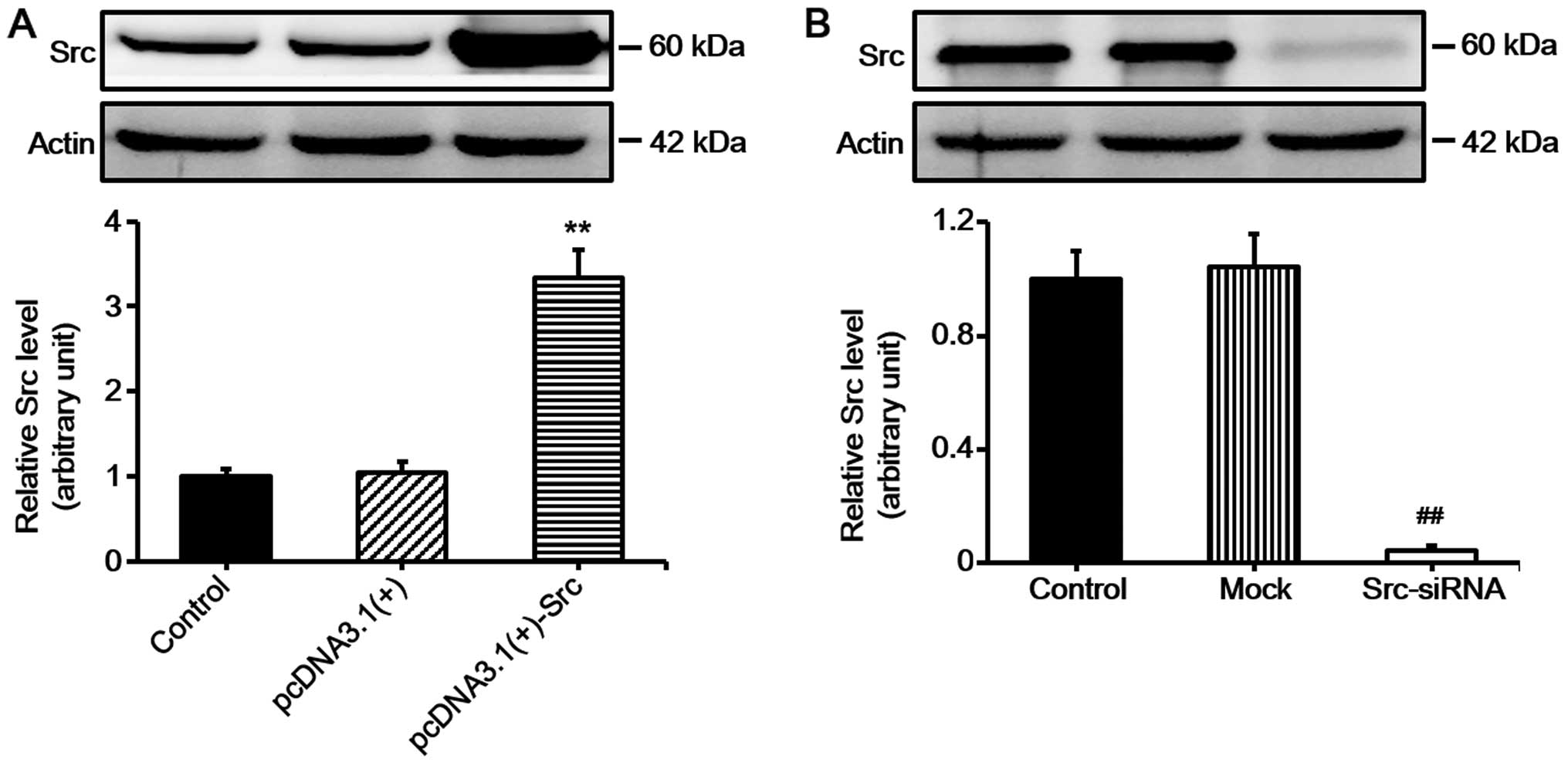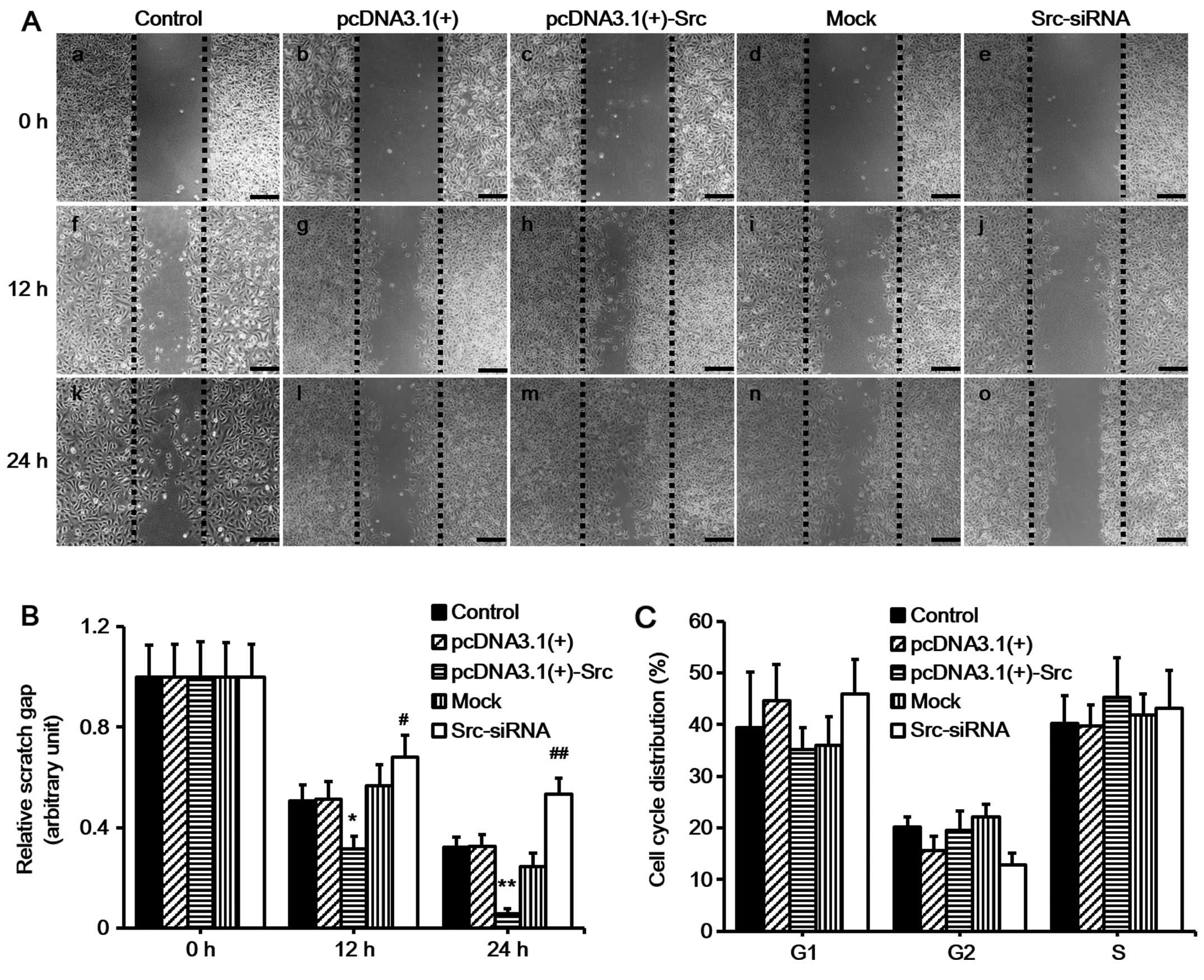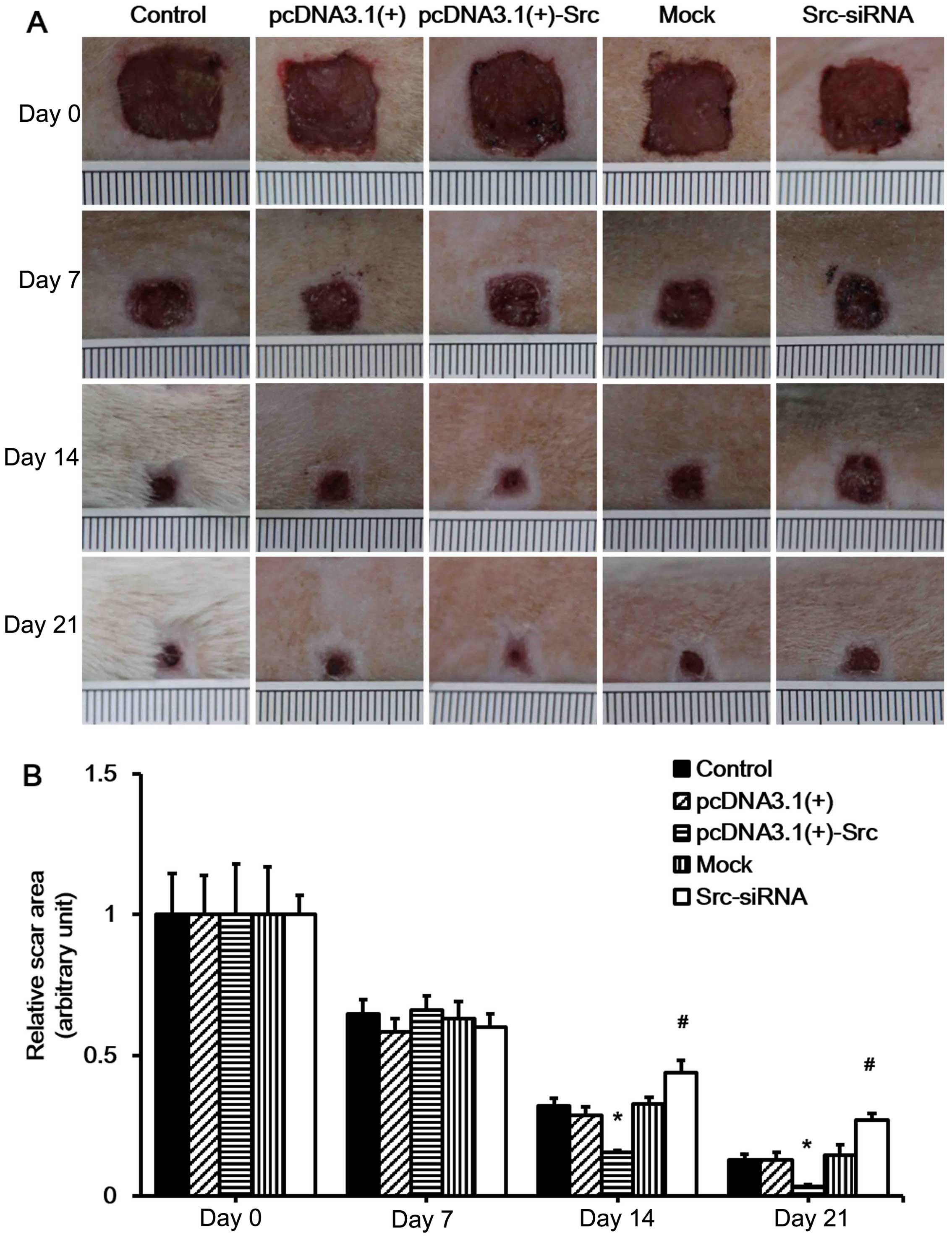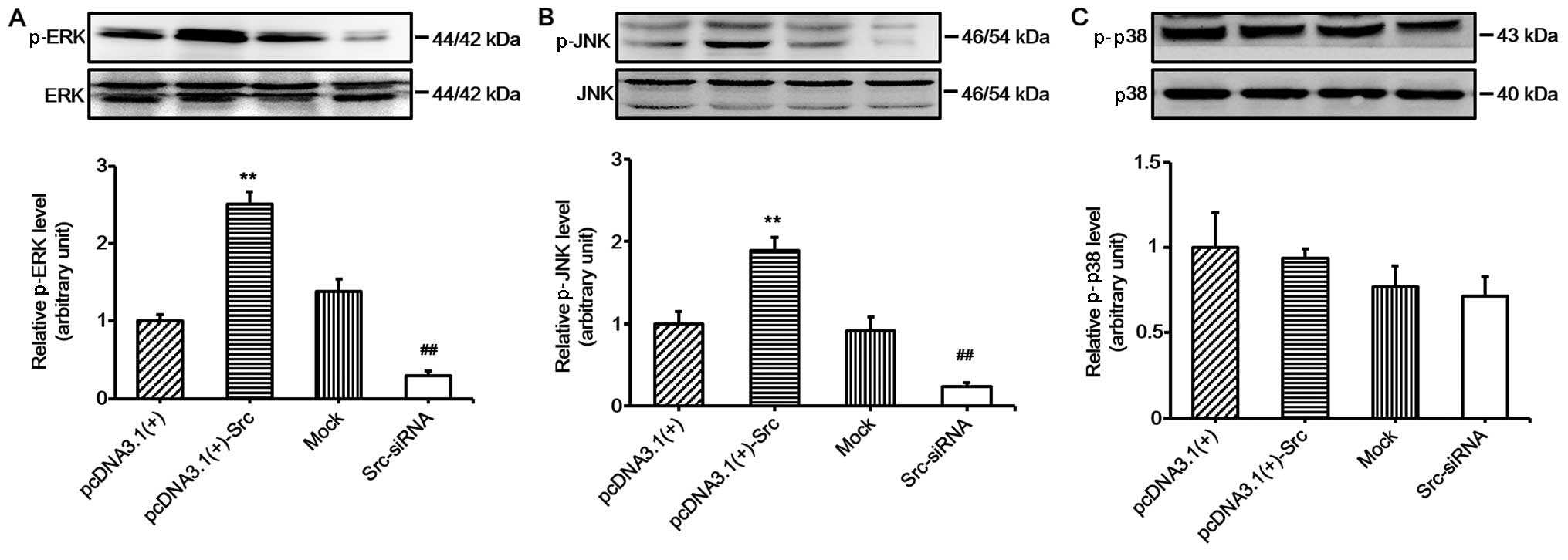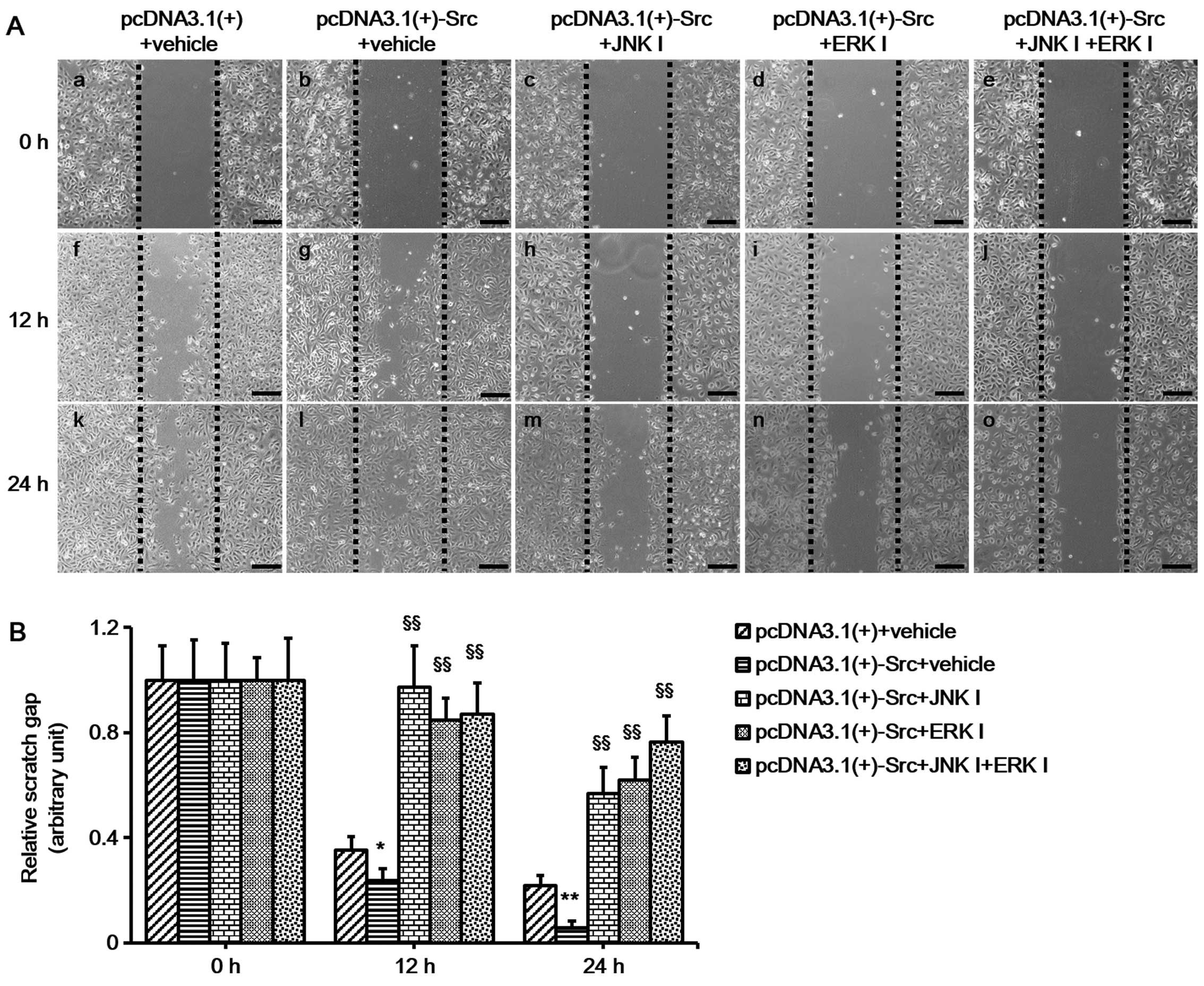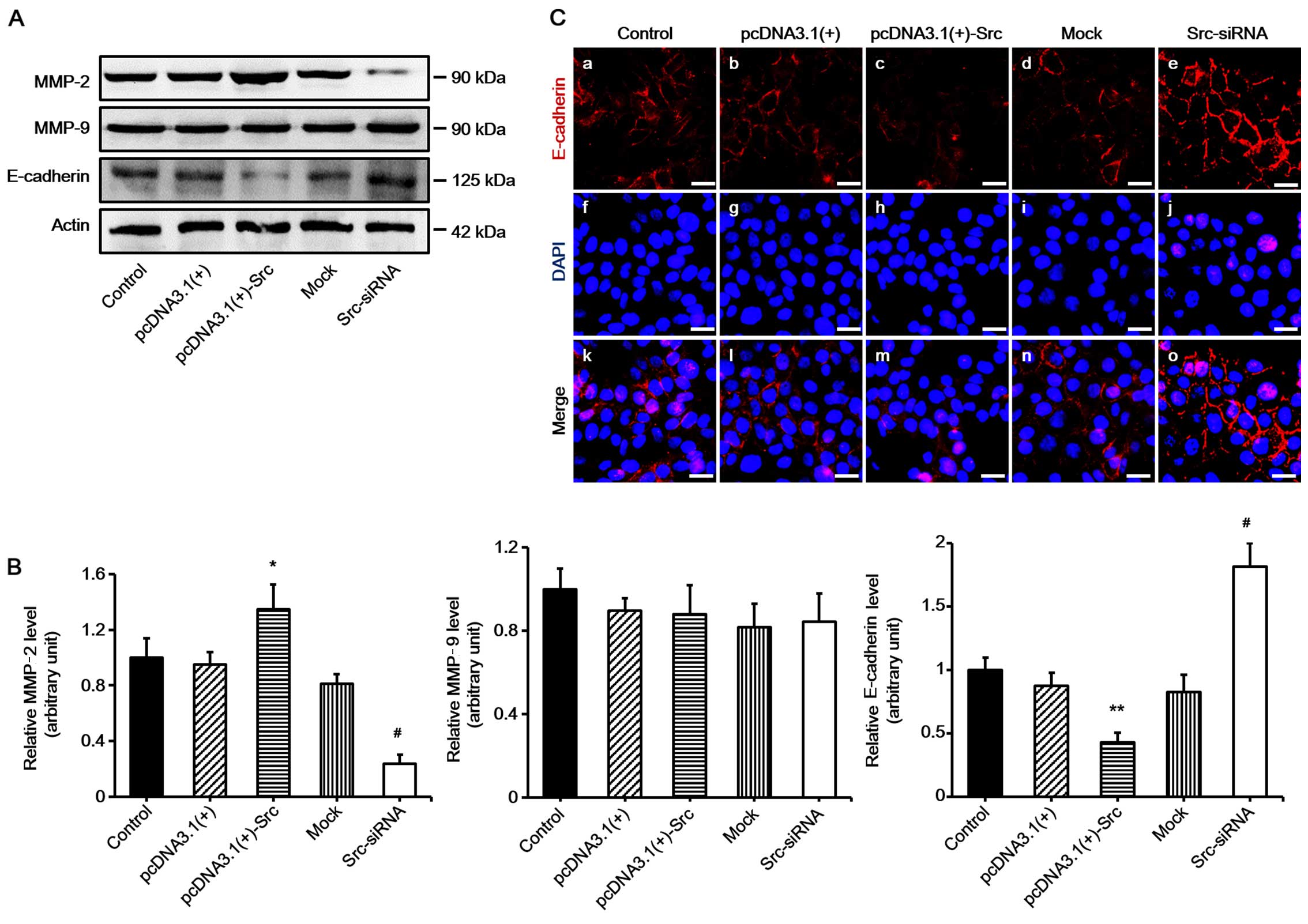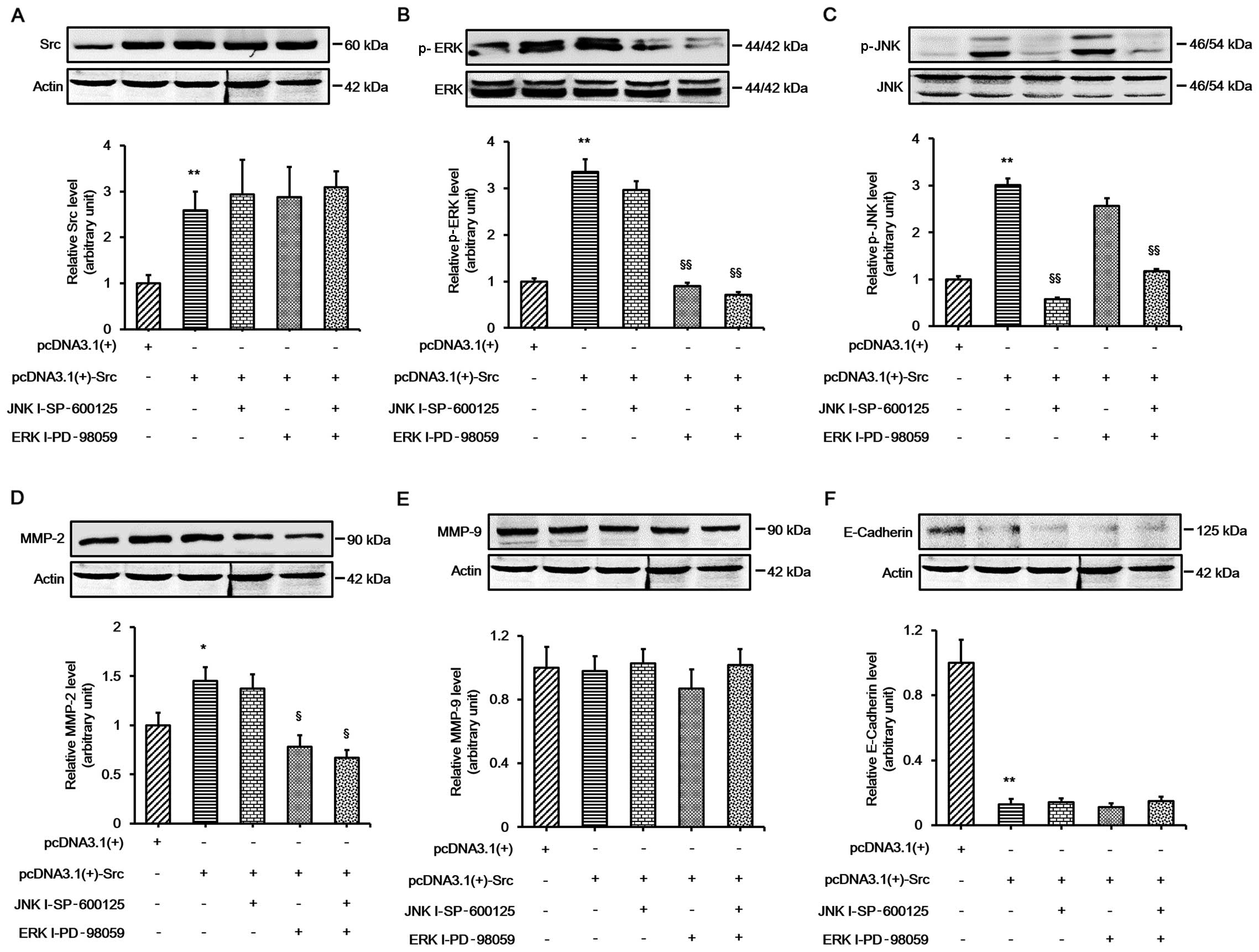|
1
|
Singer AJ and Clark RA: Cutaneous wound
healing. N Engl J Med. 341:738–746. 1999. View Article : Google Scholar : PubMed/NCBI
|
|
2
|
Santoro MM and Gaudino G: Cellular and
molecular facets of keratinocyte reepithelization during wound
healing. Exp Cell Res. 304:274–286. 2005. View Article : Google Scholar : PubMed/NCBI
|
|
3
|
Cary LA, Klinghoffer RA, Sachsenmaier C
and Cooper JA: SRC catalytic but not scaffolding function is needed
for integrin-regulated tyrosine phosphorylation, cell migration,
and cell spreading. Mol Cell Biol. 22:2427–2440. 2002. View Article : Google Scholar : PubMed/NCBI
|
|
4
|
Avizienyte E, Fincham VJ, Brunton VG and
Frame MC: Src SH3/2 domain-mediated peripheral accumulation of Src
and phosphomyosin is linked to deregulation of E-cadherin and the
epithelial-mesenchymal transition. Mol Biol Cell. 15:2794–2803.
2004. View Article : Google Scholar : PubMed/NCBI
|
|
5
|
González L, Agulló-Ortuño MT,
García-Martínez JM, Calcabrini A, Gamallo C, Palacios J, Aranda A
and Martín-Pérez J: Role of c-Src in human MCF7 breast cancer cell
tumorigenesis. J Biol Chem. 281:20851–20864. 2006. View Article : Google Scholar : PubMed/NCBI
|
|
6
|
Ishizawar R and Parsons SJ: c-Src and
cooperating partners in human cancer. Cancer Cell. 6:209–214. 2004.
View Article : Google Scholar : PubMed/NCBI
|
|
7
|
Yoo SK, Freisinger CM, LeBert DC and
Huttenlocher A: Early redox, Src family kinase, and calcium
signaling integrate wound responses and tissue regeneration in
zebrafish. J Cell Biol. 199:225–234. 2012. View Article : Google Scholar : PubMed/NCBI
|
|
8
|
Tsarouhas V, Yao L and Samakovlis C: Src
kinases and ERK activate distinct responses to Stitcher receptor
tyrosine kinase signaling during wound healing in Drosophila. J
Cell Sci. 127:1829–1839. 2014. View Article : Google Scholar : PubMed/NCBI
|
|
9
|
Gao CY, Stepp MA, Fariss R and Zelenka P:
Cdk5 regulates activation and localization of Src during corneal
epithelial wound closure. J Cell Sci. 117:4089–4098. 2004.
View Article : Google Scholar : PubMed/NCBI
|
|
10
|
Kähäri VM and Saarialho-Kere U: Matrix
metalloproteinases in skin. Exp Dermatol. 6:199–213. 1997.
View Article : Google Scholar
|
|
11
|
Madlener M, Parks WC and Werner S: Matrix
metalloproteinases (MMPs) and their physiological inhibitors
(TIMPs) are differentially expressed during excisional skin wound
repair. Exp Cell Res. 242:201–210. 1998. View Article : Google Scholar : PubMed/NCBI
|
|
12
|
Ravanti L and Kähäri VM: Matrix
metalloproteinases in wound repair (Review). Int J Mol Med.
6:391–407. 2000.PubMed/NCBI
|
|
13
|
Coussens LM, Tinkle CL, Hanahan D and Werb
Z: MMP-9 supplied by bone marrow-derived cells contributes to skin
carcinogenesis. Cell. 103:481–490. 2000. View Article : Google Scholar : PubMed/NCBI
|
|
14
|
Lin CW, Chen PN, Chen MK, Yang WE, Tang
CH, Yang SF and Hsieh YS: Kaempferol reduces matrix
metalloproteinase-2 expression by down-regulating ERK1/2 and the
activator protein-1 signaling pathways in oral cancer cells. PLoS
One. 8:e808832013. View Article : Google Scholar : PubMed/NCBI
|
|
15
|
Xue M, Le NT and Jackson CJ: Targeting
matrix metalloproteases to improve cutaneous wound healing. Expert
Opin Ther Targets. 10:143–155. 2006. View Article : Google Scholar : PubMed/NCBI
|
|
16
|
Asai J, Hirakawa S, Sakabe J, Kishida T,
Wada M, Nakamura N, Takenaka H, Mazda O, Urano T, Suzuki-Inoue K,
et al: Platelets regulate the migration of keratinocytes via
podoplanin/CLEC-2 signaling during cutaneous wound healing in mice.
Am J Pathol. 186:101–108. 2016. View Article : Google Scholar
|
|
17
|
Martin P: Wound healing - aiming for
perfect skin regeneration. Science. 276:75–81. 1997. View Article : Google Scholar : PubMed/NCBI
|
|
18
|
Thomas SM and Brugge JS: Cellular
functions regulated by Src family kinases. Annu. Rev Cell Dev Biol.
13:513–609. 1997. View Article : Google Scholar
|
|
19
|
Raja, Sivamani K, Garcia MS and Isseroff
RR: Wound re-epithelialization: modulating keratinocyte migration
in wound healing. Front Biosci. 12:2849–2868. 2007. View Article : Google Scholar : PubMed/NCBI
|
|
20
|
Pilcher BK, Wang M, Qin XJ, Parks WC,
Senior RM and Welgus HG: Role of matrix metalloproteinases and
their inhibition in cutaneous wound healing and allergic contact
hypersensitivity. Ann N Y Acad Sci. 878:12–24. 1999. View Article : Google Scholar : PubMed/NCBI
|
|
21
|
Pilcher BK, Dumin JA, Sudbeck BD, Krane
SM, Welgus HG and Parks WC: The activity of collagenase-1 is
required for keratinocyte migration on a type I collagen matrix. J
Cell Biol. 137:1445–1457. 1997. View Article : Google Scholar : PubMed/NCBI
|
|
22
|
Sudbeck BD, Pilcher BK, Welgus HG and
Parks WC: Induction and repression of collagenase-1 by
keratinocytes is controlled by distinct components of different
extracellular matrix compartments. J Biol Chem. 272:22103–22110.
1997. View Article : Google Scholar : PubMed/NCBI
|
|
23
|
Pilcher BK, Dumin J, Schwartz MJ, Mast BA,
Schultz GS, Parks WC and Welgus HG: Keratinocyte collagenase-1
expression requires an epidermal growth factor receptor autocrine
mechanism. J Biol Chem. 274:10372–10381. 1999. View Article : Google Scholar : PubMed/NCBI
|
|
24
|
Mirastschijski U, Haaksma CJ, Tomasek JJ
and Agren MS: Matrix metalloproteinase inhibitor GM 6001 attenuates
keratinocyte migration, contraction and myofibroblast formation in
skin wounds. Exp Cell Res. 299:465–475. 2004. View Article : Google Scholar : PubMed/NCBI
|
|
25
|
Agren MS: Matrix metalloproteinases (MMPs)
are required for re-epithelialization of cutaneous wounds. Arch
Dermatol Res. 291:583–590. 1999. View Article : Google Scholar
|
|
26
|
Saarialho-Kere UK: Patterns of matrix
metalloproteinase and TIMP expression in chronic ulcers. Arch
Dermatol Res. 290(Suppl): S47–S54. 1998. View Article : Google Scholar : PubMed/NCBI
|
|
27
|
Fray MJ, Dickinson RP, Huggins JP and
Occleston NL: A potent, selective inhibitor of matrix
metalloproteinase-3 for the topical treatment of chronic dermal
ulcers. J Med Chem. 46:3514–3525. 2003. View Article : Google Scholar : PubMed/NCBI
|
|
28
|
Yang Y, Bai ZG, Yin J, Wu GC and Zhang ZT:
Role of c-Src activity in the regulation of gastric cancer cell
migration. Oncol Rep. 32:45–49. 2014.PubMed/NCBI
|
|
29
|
Perez-Moreno M, Jamora C and Fuchs E:
Sticky business: orchestrating cellular signals at adherens
junctions. Cell. 112:535–548. 2003. View Article : Google Scholar : PubMed/NCBI
|
|
30
|
Takeichi M: Cadherin cell adhesion
receptors as a morphogenetic regulator. Science. 251:1451–1455.
1991. View Article : Google Scholar : PubMed/NCBI
|
|
31
|
van Roy F and Berx G: The cell-cell
adhesion molecule E-cadherin. Cell Mol Life Sci. 65:3756–3788.
2008. View Article : Google Scholar : PubMed/NCBI
|
|
32
|
Shindo M, Wada H, Kaido M, Tateno M,
Aigaki T, Tsuda L and Hayashi S: Dual function of Src in the
maintenance of adherens junctions during tracheal epithelial
morphogenesis. Development. 135:1355–1364. 2008. View Article : Google Scholar : PubMed/NCBI
|
|
33
|
Dong S, Khoo A, Wei J, Bowser RK,
Weathington NM, Xiao S, Zhang L, Ma H, Zhao Y and Zhao J: Serum
starvation regulates E-cadherin upregulation via activation of
c-Src in non-small-cell lung cancer A549 cells. Am J Physiol Cell
Physiol. 307:C893–C899. 2014. View Article : Google Scholar : PubMed/NCBI
|
|
34
|
Abreu-Blanco MT, Verboon JM, Liu R, Watts
JJ and Park-hurst SM: Drosophila embryos close epithelial wounds
using a combination of cellular protrusions and an actomyosin purse
string. J Cell Sci. 125:5984–5997. 2012. View Article : Google Scholar : PubMed/NCBI
|
|
35
|
Förster D and Luschnig S: Src42A-dependent
polarized cell shape changes mediate epithelial tube elongation in
Drosophila. Nat Cell Biol. 14:526–534. 2012. View Article : Google Scholar : PubMed/NCBI
|
|
36
|
Veracini L, Grall D, Schaub S, Beghelli-de
la Forest Divonne S, Etienne-Grimaldi MC, Milano G, Bozec A, Babin
E, Sudaka A, Thariat J and Van Obberghen-Schilling E: Elevated Src
family kinase activity stabilizes E-cadherin-based junctions and
collective movement of head and neck squamous cell carcinomas.
Oncotarget. 6:7570–7583. 2014. View Article : Google Scholar
|
|
37
|
Deo DD, Axelrad TW, Robert EG, Marcheselli
V, Bazan NG and Hunt JD: Phosphorylation of STAT-3 in response to
basic fibroblast growth factor occurs through a mechanism involving
platelet-activating factor, JAK-2, and Src in human umbilical vein
endothelial cells. Evidence for a dual kinase mechanism. J Biol
Chem. 277:21237–21245. 2002. View Article : Google Scholar : PubMed/NCBI
|
|
38
|
Goel R, Phillips-Mason PJ, Raben DM and
Baldassare JJ: alpha-Thrombin induces rapid and sustained Akt
phosphorylation by beta-arrestin1-dependent and -independent
mechanisms, and only the sustained Akt phosphorylation is essential
for G1 phase progression. J Biol Chem. 277:18640–18648. 2002.
View Article : Google Scholar : PubMed/NCBI
|
|
39
|
Wu W, Graves LM, Gill GN, Parsons SJ and
Samet JM: Src-dependent phosphorylation of the epidermal growth
factor receptor on tyrosine 845 is required for zinc-induced Ras
activation. J Biol Chem. 277:24252–24257. 2002. View Article : Google Scholar : PubMed/NCBI
|
|
40
|
Callera GE, Touyz RM, Tostes RC, Yogi A,
He Y, Malkinson S and Schiffrin EL: Aldosterone activates vascular
p38MAP kinase and NADPH oxidase via c-Src. Hypertension.
45:773–779. 2005. View Article : Google Scholar : PubMed/NCBI
|
|
41
|
Khadaroo RG, He R, Parodo J, Powers KA,
Marshall JC, Kapus A and Rotstein OD: The role of the Src family of
tyrosine kinases after oxidant-induced lung injury in vivo.
Surgery. 136:483–488. 2004. View Article : Google Scholar : PubMed/NCBI
|
|
42
|
Khadaroo RG, Parodo J, Powers KA, Papia G,
Marshall JC, Kapus A and Rotstein OD: Oxidant-induced priming of
the macrophage involves activation of p38 mitogen-activated protein
kinase through an Src-dependent pathway. Surgery. 134:242–246.
2003. View Article : Google Scholar : PubMed/NCBI
|
|
43
|
Chen Y, Ramakrishnan DP and Ren B:
Regulation of angiogenesis by phospholipid lysophosphatidic acid.
Front Biosci (Landmark Ed). 18:852–861. 2013. View Article : Google Scholar
|
|
44
|
He M, Xue ZM, Li J and Zhou BQ:
Breviscapine inhibits high glucose-induced proliferation and
migration of cultured vascular smooth muscle cells of rats via
suppressing the ERK1/2 MAPK signaling pathway. Acta Pharmacol Sin.
33:606–614. 2012. View Article : Google Scholar : PubMed/NCBI
|
|
45
|
Makino T, Jinnin M, Muchemwa FC, Fukushima
S, Kogushi-Nishi H, Moriya C, Igata T, Fujisawa A, Johno T and Ihn
H: Basic fibroblast growth factor stimulates the proliferation of
human dermal fibroblasts via the ERK1/2 and JNK pathways. Br J
Dermatol. 162:717–723. 2010. View Article : Google Scholar
|
|
46
|
Yue GG, Fan JT, Lee JK, Zeng GZ, Ho TW,
Fung KP, Leung PC, Tan NH and Lau CB: Cyclopeptide RA-V inhibits
angiogenesis by down-regulating ERK1/2 phosphorylation in HUVEC and
HMEC-1 endothelial cells. Br J Pharmacol. 164:1883–1898. 2011.
View Article : Google Scholar : PubMed/NCBI
|
|
47
|
Gazel A, Nijhawan RI, Walsh R and
Blumenberg M: Transcriptional profiling defines the roles of ERK
and p38 kinases in epidermal keratinocytes. J Cell Physiol.
215:292–308. 2008. View Article : Google Scholar : PubMed/NCBI
|
|
48
|
Boulton TG, Nye SH, Robbins DJ, Ip NY,
Radziejewska E, Morgenbesser SD, DePinho RA, Panayotatos N, Cobb MH
and Yancopoulos GD: ERKs: a family of protein-serine/threonine
kinases that are activated and tyrosine phosphorylated in response
to insulin and NGF. Cell. 65:663–675. 1991. View Article : Google Scholar : PubMed/NCBI
|
|
49
|
Kim MS, Kim YK, Eun HC, Cho KH and Chung
JH: All-trans retinoic acid antagonizes UV-induced VEGF production
and angiogenesis via the inhibition of ERK activation in human skin
keratinocytes. J Invest Dermatol. 126:2697–2706. 2006. View Article : Google Scholar : PubMed/NCBI
|
|
50
|
Matsubayashi Y, Ebisuya M, Honjoh S and
Nishida E: ERK activation propagates in epithelial cell sheets and
regulates their migration during wound healing. Curr Biol.
14:731–735. 2004. View Article : Google Scholar : PubMed/NCBI
|
|
51
|
Ennis BW, Fultz KE, Smith KA, Westwick JK,
Zhu D, Boluro-Ajayi M, Bilter GK and Stein B: Inhibition of tumor
growth, angiogenesis, and tumor cell proliferation by a small
molecule inhibitor of c-Jun N-terminal kinase. J Pharmacol Exp
Ther. 313:325–332. 2005. View Article : Google Scholar : PubMed/NCBI
|
|
52
|
Harper EG, Alvares SM and Carter WG:
Wounding activates p38 map kinase and activation transcription
factor 3 in leading keratinocytes. J Cell Sci. 118:3471–3485. 2005.
View Article : Google Scholar : PubMed/NCBI
|



